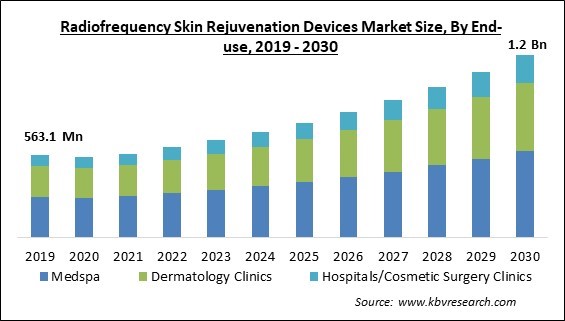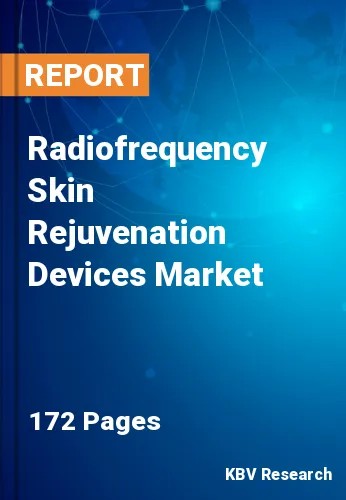The Global Radiofrequency Skin Rejuvenation Devices Market size is expected to reach $1.2 billion by 2030, rising at a market growth of 9.3% CAGR during the forecast period.
Wrinkle reduction is one of the major applications of radiofrequency skin rejuvenation devices because of the growing aging population as age anxiety, worries about facial changes, and an urge to look younger have all contributed to the popularity of dermal fillers among middle-aged adults. Therefore, the wrinkle reduction segment is expected to generate approximately 32% share of the market by 2030. For example, the World Bank estimates that by 2050, there will be twice as many individuals over 65 in Latin America as there are now. Similar to this, it is estimated by Eurostat that by 2050 there will be about 500,000 centenarians living in the EU-27. Some of the factors impacting the market are rising frequency of skin-related and the number of skin cosmetic operations, increasing technological developments in skin rejuvenation procedures, and side effects of RF procedures and a lack of skilled professionals.

Widespread use of multiple device-based skin rejuvenation treatments is being caused by the rising prevalence of skin-related issues like wrinkles, acne, scars, sun-damaged skin, and hyperpigmentation, which is expected to fuel the growth of the market. Thus, the market will expand when demand for aesthetic appearances and skin diseases rises. The growing inclination for minimally invasive treatments and procedures, technological developments in radiofrequency-based devices, as well as additional health and economic benefits over alternative aesthetic procedures are increasing the demand for RF procedures. Hence, these elements are propelling the expansion of the market.
However, post-treatment erythema, blistering, and burns on the skin are examples of adverse reactions that can occur as a result of radiofrequency (RF) cosmetic treatments. Even while the majority of the treatment's adverse effects clear up in a very short amount of time, there is a possibility that some could result in serious consequences depending on the skin's texture and pigmentation. Thus, these elements may hamper the expansion of the market. The skin rejuvenation industry, particularly radiofrequency skin rejuvenation demand, was significantly impacted by the COVID-19 pandemic. The businesses in the market first faced challenges as a result of aesthetic clinics as well as medical spas temporarily closing or operating at reduced capacity due to the strict lockdown. Due to the decline in surgical treatments during the COVID-19 pandemic, the demand for skin rejuvenation therapies declined further. Consequently, though the pandemic had an unfavorable impact on the market, with the rise in minimally invasive skin rejuvenation procedures, the market will grow significantly in the coming years.
Based on application, the market is characterized into skin tightening, wrinkle reduction, scar treatment, and others. The skin tightening segment garnered the highest revenue share in the market in 2022. The growth of the segment is owed to the advantages of the technique. The popularity of skin tightening procedures has increased as a result of significant developments in aesthetic medicine and dermatology. Skin tightening, a non-surgical procedure to firm drooping skin, involves heating the dermis, the deepest layer of the skin, using energy waves. This process encourages the creation of elastin and collagen.

On the basis of end-use, the market is classified into medspa, dermatology clinics, and hospitals/cosmetic surgery clinics. The hospitals/cosmetic surgery clinics segment recorded a significant revenue share in the market in 2022. Two causes, including a rise in the adoption of aesthetic or cosmetic procedures in hospitals along with an increase in government spending to promote the healthcare sector, can be linked to the growth of this segment. Due to the relatively high quality and effectiveness of radiofrequency skin rejuvenation operations, hospitals are the best settings to perform them.
| Report Attribute | Details |
|---|---|
| Market size value in 2022 | USD 617.5 Million |
| Market size forecast in 2030 | USD 1.2 Billion |
| Base Year | 2022 |
| Historical Period | 2019 to 2021 |
| Forecast Period | 2023 to 2030 |
| Revenue Growth Rate | CAGR of 9.3% from 2023 to 2030 |
| Number of Pages | 172 |
| Number of Table | 269 |
| Report coverage | Market Trends, Revenue Estimation and Forecast, Segmentation Analysis, Regional and Country Breakdown, Companies Strategic Developments, Company Profiling |
| Segments covered | Application, End-use, Region |
| Country scope | US, Canada, Mexico, Germany, UK, France, Russia, Spain, Italy, China, Japan, India, South Korea, Singapore, Malaysia, Brazil, Argentina, UAE, Saudi Arabia, South Africa, Nigeria |
| Growth Drivers |
|
| Restraints |
|
Region wise, the market is analyzed across North America, Europe, Asia Pacific, and LAMEA. The North America segment witnessed the maximum revenue share in the rad market in 2022. This development can be linked to the region's substantial population as well as the growing interest in aesthetics, which has raised the need for minimally invasive procedures. The procedure presents a desirable alternative for those looking to improve the texture of their skin, lessen wrinkles, and look younger. The availability of cutting-edge tools and therapies in this region draws clients and professionals, boosting the growth of the market.
Free Valuable Insights: Global Radiofrequency Skin Rejuvenation Devices Market size to reach USD 1.2 Billion by 2030
The market research report covers the analysis of key stake holders of the market. Key companies profiled in the report include Bausch Health Companies, Inc. (Solta Medical), Alma Lasers Ltd. (Sisram Medical Ltd.), F Care Systems, Cynosure, LLC, Lumenis Be Ltd., Candela Corporation, Cutera, Inc., Fotona d.o.o and Lutronic Co., Ltd.
By Application
By End-Use
By Geography
The Market size is projected to reach USD 1.2 billion by 2030.
Rising frequency of skin-related and the number of skin cosmetic operations are driving the Market in coming years, however, Side effects of RF procedures and a lack of skilled professionals restraints the growth of the Market.
Bausch Health Companies, Inc. (Solta Medical), Alma Lasers Ltd. (Sisram Medical Ltd.), F Care Systems, Cynosure, LLC, Lumenis Be Ltd., Candela Corporation, Cutera, Inc., Fotona d.o.o and Lutronic Co., Ltd.
The expected CAGR of this Market is 9.3% from 2023 to 2030.
The Medspa segment is leading the Global Radiofrequency Skin Rejuvenation Devices Market by End-use in 2022 thereby, achieving a market value of $590.5 million by 2030.
The North America market dominated the Global Radiofrequency Skin Rejuvenation Devices Market by Region in 2022, and would continue to be a dominant market till 2030; thereby, achieving a market value of $466.9 million by 2030.
Our team of dedicated experts can provide you with attractive expansion opportunities for your business.

